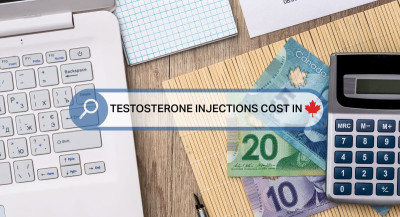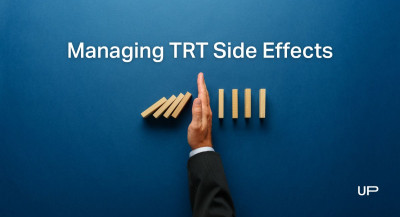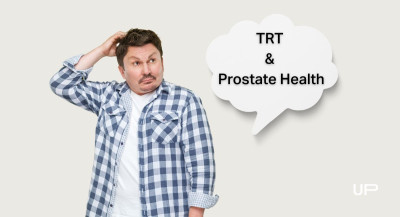Does TRT Worsen Sleep Apnea? What Men Need To Know


For men considering testosterone replacement therapy (TRT) in Canada, one common concern is its possible link to sleep apnea.

Some have heard that TRT can trigger or worsen sleep-related breathing issues, leading to hesitation or confusion about starting treatment. While the fear isn’t entirely unfounded, it’s often based on misunderstanding or outdated information.
This article breaks down what the science actually says, who may be at risk, and how men can manage both TRT and sleep apnea safely with proper medical support.
Topics covered in this article:
- What Is Sleep Apnea? Why It Matters in Midlife
- The Science So Far: What Studies Say About TRT and Apnea
- Who’s Most at Risk?
- Managing the Risk: Safe TRT with Sleep Apnea
- Should You Stop TRT If You Have Apnea?
- Alternatives and Adjustments
- UPGUYS Approach to Safe TRT
- Conclusion: TRT and Sleep Apnea Can Coexist, With Care
- References
What Is Sleep Apnea? Why It Matters in Midlife
Sleep apnea is a condition where breathing repeatedly stops or becomes shallow during sleep. The two main types are obstructive sleep apnea (OSA), caused by blocked airways, and central sleep apnea (CSA), which involves the brain failing to send proper signals to the muscles that control breathing.

For men in midlife, especially over age 40, sleep apnea is surprisingly common. Hormonal shifts, weight gain, and decreased muscle tone in the airway can all increase the risk. Low testosterone itself has been linked to poor sleep quality, and as men age, they may face a dual challenge: declining hormone levels and a rising risk of sleep-disordered breathing. That’s why understanding the overlap between sleep apnea and testosterone therapy matters for long-term health.
The Science So Far: What Studies Say About TRT and Apnea
Research on the link between testosterone replacement therapy (TRT) and sleep apnea remains mixed.
Some clinical trials, like a randomized controlled study in obese men with severe obstructive sleep apnea (OSA), found that TRT mildly worsened sleep-disordered breathing in the first few weeks of treatment but showed no lasting effects by 18 weeks.
Other studies suggest testosterone may influence breathing control through changes in central respiratory regulation rather than directly obstructing the airway.
An earlier study also reported that short-term, high-dose testosterone reduced sleep duration and increased nighttime oxygen desaturation.
While these findings raise valid concerns, current evidence does not show that properly managed TRT consistently causes or worsens sleep apnea in the general male population.
Still, individualized care and regular monitoring are essential, especially for men with existing risk factors for sleep-disordered breathing.

Who’s Most at Risk?
Not every man on testosterone replacement therapy (TRT) in Canada faces the same risk when it comes to sleep apnea. Research shows that certain groups are more vulnerable to complications or symptom worsening, especially if pre-existing risk factors are involved.
Here’s who may be at higher risk:
- Men with untreated or severe obstructive sleep apnea (OSA): Adding TRT without first addressing sleep apnea can potentially worsen oxygen saturation during sleep.
- Men with obesity: Excess weight is already a strong contributor to OSA. Combining it with TRT may further elevate the risk by affecting airway function and breathing regulation.
- Those with naturally high baseline testosterone levels: If testosterone is already in the upper range, adding more may increase the chance of sleep-related breathing changes.
- Men who self-medicate without medical supervision: Taking testosterone without proper diagnosis, dosing, and monitoring increases the chances of overexposure and missed signs of sleep-disordered breathing.
For these groups, extra care is critical. A comprehensive health review and sleep assessment should be part of any TRT plan, especially for men over 40.
Managing the Risk: Safe TRT with Sleep Apnea
Testosterone replacement therapy (TRT) in Canada can still be a safe and effective option for men with or at risk for sleep apnea, as long as it’s managed carefully. The key is to take a proactive, team-based approach to treatment.
Here’s how to do it right:
- Get diagnosed first: Before starting TRT, men with symptoms like loud snoring, daytime fatigue, or poor sleep quality should undergo a sleep study. Identifying obstructive sleep apnea (OSA) early allows for proper treatment and risk reduction.
- Monitor throughout treatment: If you’re already on TRT, ongoing evaluation of your sleep health is essential. That might include repeat sleep studies, checking oxygen levels, or tracking symptoms with the help of your healthcare provider.
- Work with the right team: Collaborating with both a sleep specialist and a licensed TRT provider ensures that any overlapping risks are addressed. A coordinated care plan helps prevent complications and supports long-term health.
TRT doesn’t have to be off the table for men with sleep apnea. With the right precautions, many can experience the benefits of hormone therapy without worsening their sleep.
Should You Stop TRT If You Have Apnea?
Having sleep apnea doesn’t automatically mean you need to stop testosterone replacement therapy (TRT). The decision depends on how severe your sleep apnea is and how your body responds to treatment.

For some men, untreated or severe obstructive sleep apnea (OSA) can worsen when starting TRT, especially if no sleep management plan is in place. But for others, especially those already using treatments like CPAP machines or oral appliances, TRT may not pose a significant risk.
What matters most is treating both conditions properly:
- Sleep apnea should be diagnosed and managed, not ignored.
- Low testosterone should be confirmed through labs and managed under medical supervision.
There’s no one-size-fits-all answer. That’s why shared decision-making between you, your sleep specialist, and your TRT provider is essential. Together, you can weigh the benefits and risks and make a plan that supports both your energy and your sleep.
Alternatives and Adjustments
If you're managing both low testosterone and sleep apnea, there are several strategies that may reduce risks and improve outcomes. Adjusting your approach to testosterone replacement therapy (TRT) or addressing sleep apnea directly can make a big difference.
Consider these options:
- TRT dose adjustments: In some cases, lowering the dose or switching from a higher peak method (like injections) to a more stable option (like gel or patch) can reduce the impact on sleep-related breathing.
- Trying non-injectable TRT methods: Topical testosterone or other delivery forms may create fewer hormonal spikes, which could be gentler on sleep quality for some men.
- Weight loss and CPAP as apnea solutions: Shedding even 5 to 10 percent of body weight can improve obstructive sleep apnea significantly. Using CPAP therapy consistently is also proven to restore restful sleep and reduce health risks.
These approaches don’t require choosing between treating low T and managing sleep apnea. With proper guidance, you can support both safely.
UPGUYS Approach to Safe TRT
At UPGUYS, patient safety is at the core of how we deliver testosterone replacement therapy (TRT) in Canada. Our licensed Canadian doctors follow a thorough screening process before starting treatment, which includes assessing for conditions like sleep apnea.

Every patient receives a customized dosage plan based on their lab results, symptoms, and medical history. For men with diagnosed or suspected obstructive sleep apnea (OSA), we proceed with extra care. If TRT is deemed appropriate, our medical team continues to monitor symptoms and lab values over time to ensure treatment remains safe and effective.
UPGUYS does not rush or generalize care. We offer medically supervised TRT with built-in follow-ups and ongoing oversight, especially for patients managing more complex health conditions.
Conclusion: TRT and Sleep Apnea Can Coexist, With Care
Testosterone replacement therapy (TRT) in Canada does not automatically mean sleep apnea will develop or worsen. While research is ongoing, current evidence does not support a direct link for most men when therapy is prescribed and monitored properly.
If you have sleep apnea or think you might, it’s essential to get diagnosed and treated. With the right medical support, from both sleep and hormone specialists, men can often manage both low testosterone and sleep apnea safely. The key is informed decision-making, not fear-based avoidance.

References
UPGUYS has strict sourcing guidelines to ensure our content is accurate and current. We rely on peer-reviewed studies, academic research institutions, and medical associations. We strive to use primary sources and refrain from using tertiary references.- The complex relation between obstructive sleep apnoea syndrome, hypogonadism and testosterone replacement therapy, PubMed,
https://pubmed.ncbi.nlm.nih.gov/37881222/ - Obstructive Sleep Apnea and Testosterone Deficiency, PubMed,
https://pubmed.ncbi.nlm.nih.gov/29774669/ - The Short-Term Effects of High-Dose Testosterone on Sleep, Breathing, and Function in Older Men, JCEM,
https://academic.oup.com/jcem/article-abstract/88/8/3605/2845283?redirectedFrom=fulltext - Testosterone therapy and obstructive sleep apnea: is there a real connection? PubMed,
https://pubmed.ncbi.nlm.nih.gov/17645445/
This article is written for informational purposes only and does not constitute medical advice. The information provided in the articles cannot and should not replace advice from a healthcare professional. Talk to your healthcare provider about any physical or mental health concerns or the risks and benefits of any treatment or medication.





